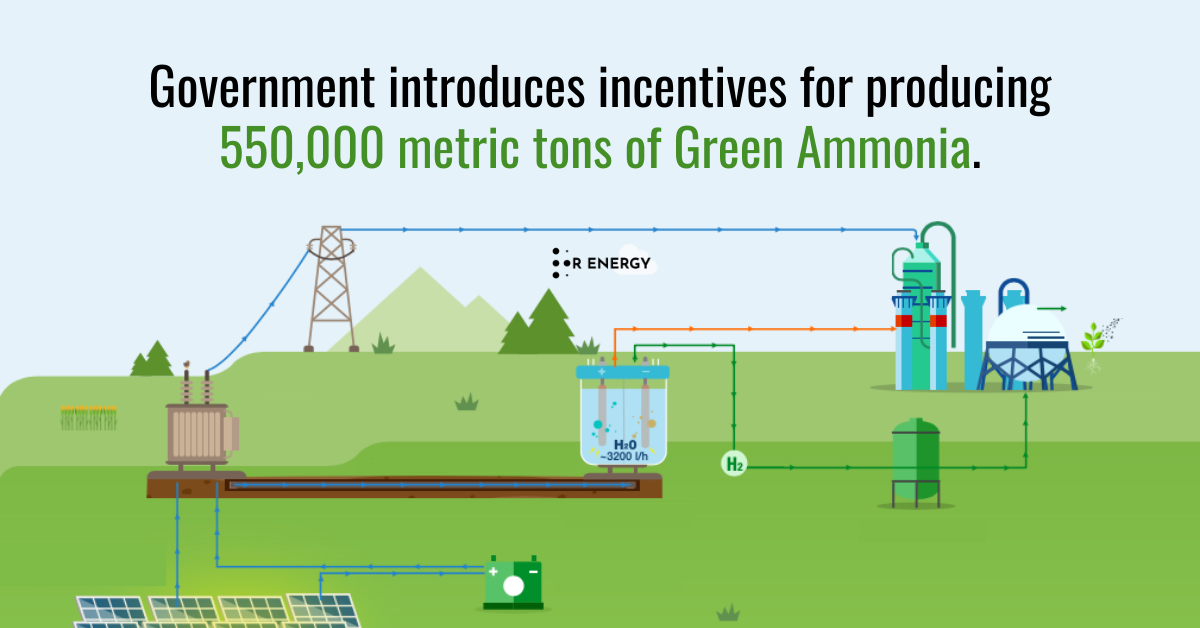The Ministry of New and Renewable Energy (MNRE) in India has recently established a comprehensive incentive framework for the production and supply of green ammonia. This initiative is part of the Strategic Interventions for Green Hydrogen Transition (SIGHT) program, specifically under Mode 2A.
The primary goal is to foster the production of green ammonia at the lowest possible cost through a competitive selection process. This article delves into the various aspects of this framework, outlining its structure, implementation, and potential impact on the renewable energy sector.
Overview of the SIGHT Program and Incentive Structure
The SIGHT program, spearheaded by MNRE, is a strategic move towards promoting green hydrogen and its derivatives, including green ammonia. The incentive implementation framework under Mode 2A is a critical component of this initiative. The program allocates a total outlay of ₹130.5 billion ($1.57 billion) for incentivizing the production of green hydrogen and its derivatives. The incentive structure is designed to decrease annually over three years, starting from ₹8.82 ($0.11) per kg in the first year, ₹7.06 ($0.085) per kg in the second year, and ₹5.30 ($0.064) per kg in the third year. This structured approach aims to encourage early adoption and gradual market adaptation.
Role of Solar Energy Corporation of India (SECI)
The Solar Energy Corporation of India (SECI) plays a pivotal role as the implementing agency for this program. SECI’s responsibilities are multifaceted, including the processing of applications, issuance of acknowledgements and awards, and examination of incentive claims. Additionally, SECI is tasked with compiling data on the program’s progress and submitting quarterly reports to MNRE. For its services, SECI is entitled to receive an administrative charge of 0.5% of the annual disbursed incentive amount.
Capacity Allocation and Bidding Process
The initial capacity available for bidding under Tranche I of Mode 2A is set at 550,000 MT per annum of green ammonia. SECI holds the authority to set minimum and maximum capacity limits for bids and manage the allocation process. Unallocated capacity from one tranche can be carried over to the next, ensuring flexibility and continuity in the program.
Incentive Payout and Allocation
The incentive payout is calculated based on the lower of the allocated capacity or actual production and supply in a given year. This payout is disbursed annually to successful bidders after due verification by MNRE through SECI. The allocated capacity remains constant for the three years, providing a stable framework for producers.
Green Hydrogen Standards
To qualify for the incentives, producers must adhere to the ‘National Green Hydrogen Standard’ set by MNRE. This standard dictates the quantity of green hydrogen used per kg of green ammonia, directly influencing the incentive amount. Compliance with these standards ensures the environmental integrity of the produced green ammonia.
Eligibility Criteria for Bidders
Bidders interested in participating in the program must meet specific financial criteria, including a net worth of at least ₹50 million (~$601,181) per 1,000 MT/Annum of quoted production and supply capacity. The program is open to single companies, joint ventures, or consortia.
Penalties and Compliance
The framework includes provisions for earnest money deposits (EMD) and performance bank guarantees (PBG), with specific conditions for forfeiture in cases of non-compliance or default. Successful bidders are also required to sign an Agreement of Power Purchase (APA) with procurers, linking adherence to the APA terms with the disbursement of incentives.
Monitoring and Oversight
A program monitoring committee, co-chaired by high-ranking officials and including necessary experts, is established to oversee the program. This committee is responsible for assessing progress, addressing challenges, and ensuring the smooth implementation of the program.
Contextual Background and Future Prospects
This incentive framework is part of a broader initiative by MNRE, which includes programs for the manufacturing of electrolyzers and the production of green hydrogen. The combined financial outlay for these initiatives is substantial, indicating the government’s commitment to renewable energy. The introduction of such programs is expected to significantly boost the production of green ammonia, contributing to India’s renewable energy goals and reducing its carbon footprint.
Conclusion
In conclusion, the MNRE’s incentive framework under the SIGHT program represents a significant step towards promoting green ammonia production in India. By providing a structured and supportive environment, the program aims to catalyze the transition to green hydrogen and its derivatives, marking a pivotal moment in India’s renewable energy journey.


